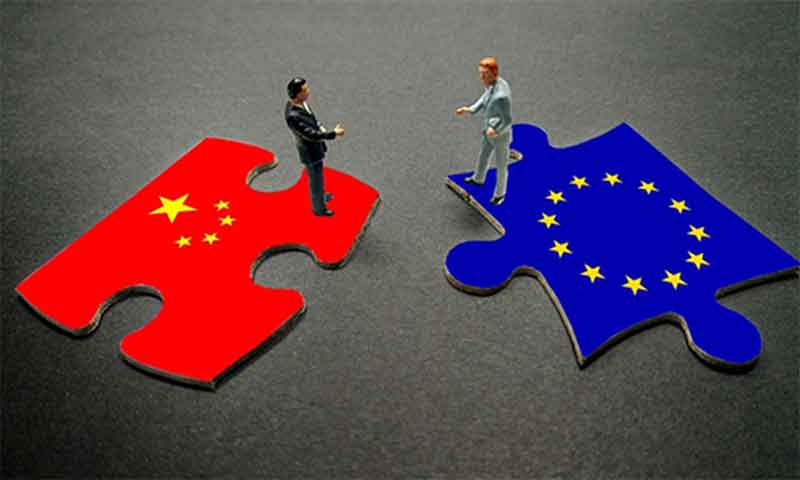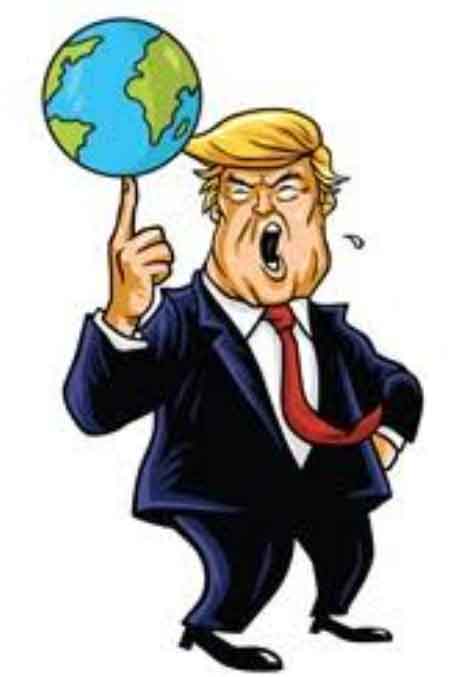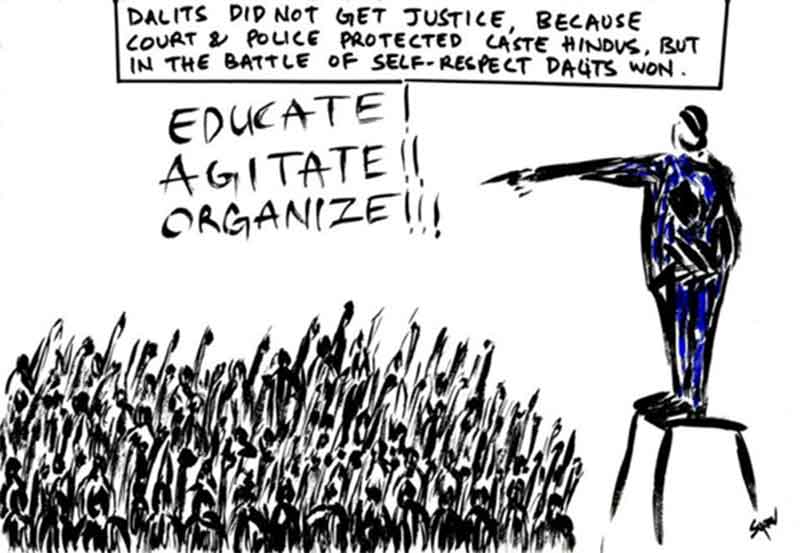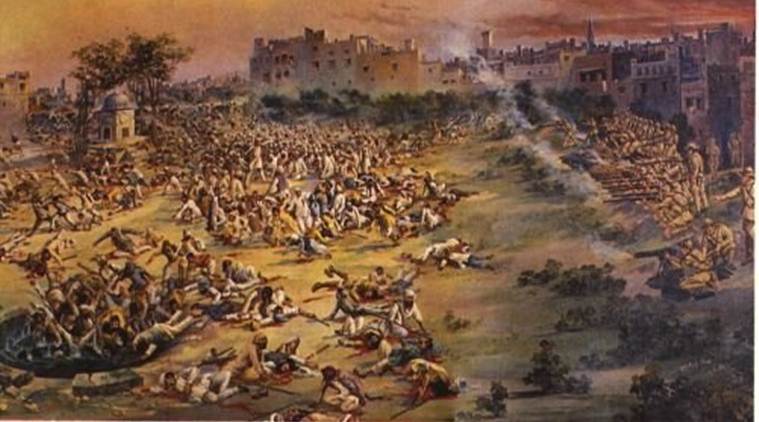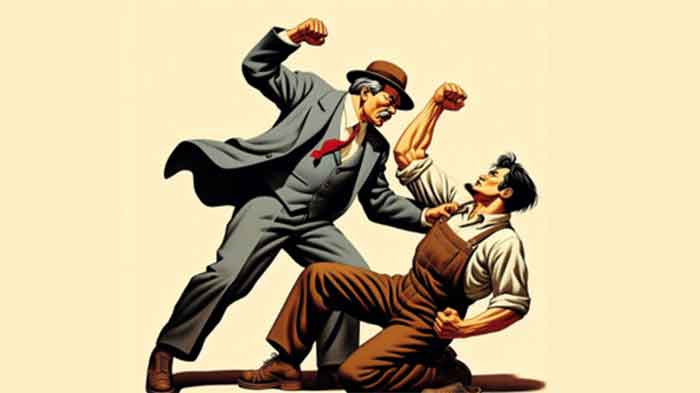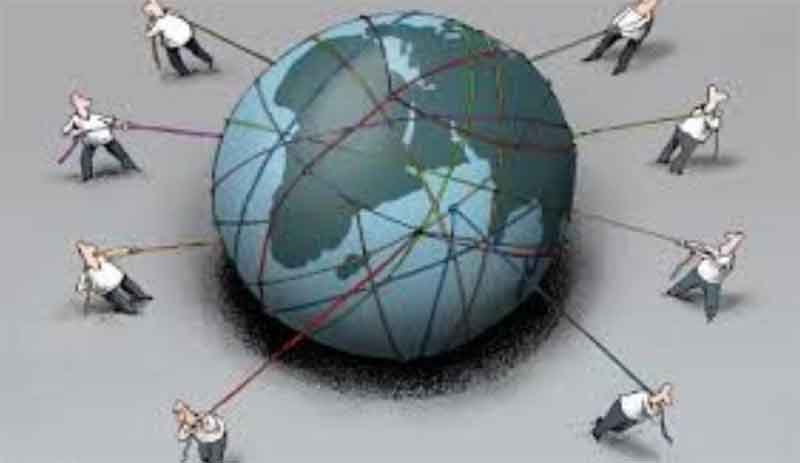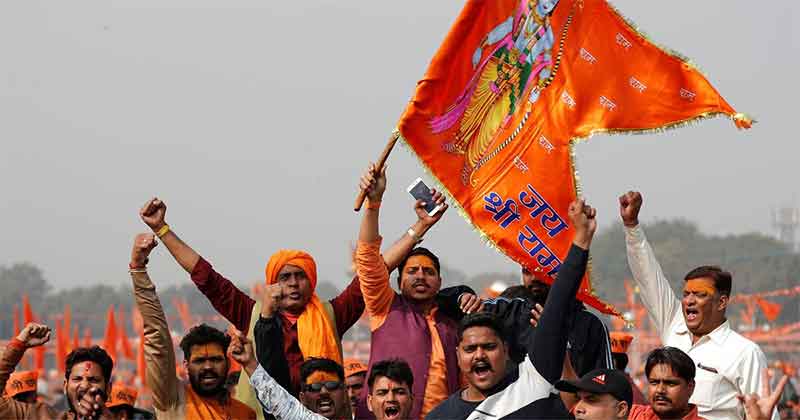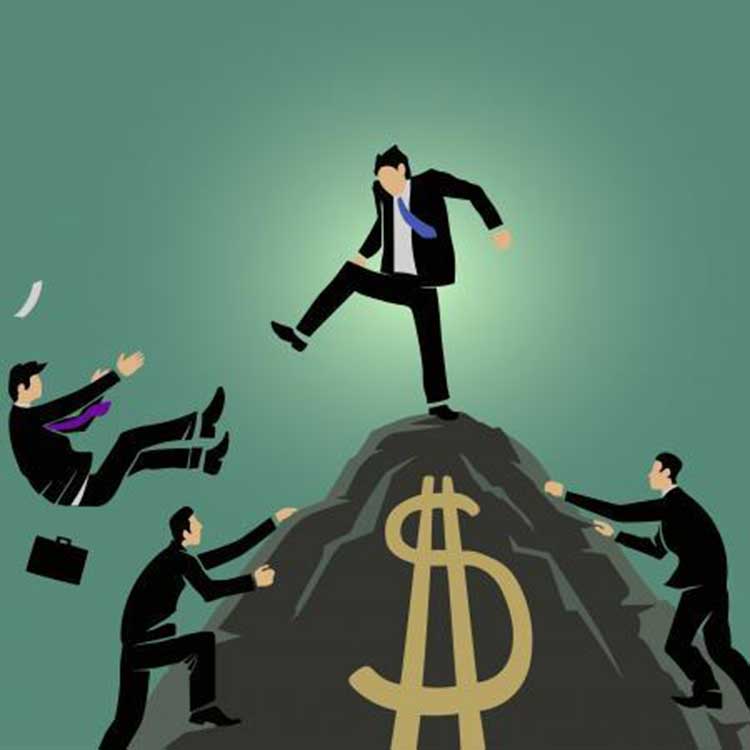
The current economic crisis has been interpreted variously. To most of the analysts it is merely a crisis of the new globalized financial system and the absence of any effective global regulatory mechanism. Another variant of the theme points the finger to the policy of completely freeing the American corporate, especially the financial corporate, oligarchy of any regulatory authority at all and making virtue out of the unbridled pursuit of speculative profits. The blame has been shifted to the recklessness and irresponsibility of the financial institutions. This line of thinking does not see the current crisis as the inevitable crisis of the capitalist system itself, particularly the market fundamentalist version (TINA). The question, however, is why should the peoples of the world bear the cost of this crisis inequitably and not search for an alternative?
The dominant and conventional description of the system is that it is a free market economy and the economic theory behind its working is called the “neoclassical” theory. The neoclassical theory is claimed to be as universal and timeless as the theories of Einstein. The economic system has been termed as capitalism by Marx. He showed that it is only one of the passing phases of development of societies.
The neoclassical theory makes many heroic restrictive assumptions about the real world: (1) An economy is defined as a system of unregulated or ‘free’ markets consisting of set of actions we call buying and selling. (2) Each of these buyers and sellers is assumed to be a single-minded “maximizer,” maximizing his or her satisfaction or profit. He is supposed only to look after his own self-interest. (3) He is rational player. Rational individuals do not repeat mistakes. (4) In every market there are numerous independent and isolated (independent of each other) buyers and sellers. No individual buyer or seller can influence or control prices. (5) The business firm is assumed to be the equivalent of an individual; the relationships among people inside the firm are ignored. (6) Every player in every market also has complete knowledge concerning everything that might influence his or her decisions. (7) There is private ownership of means of production and property.
The result is that the invisible hand of market automatically delivers prices and quantities for all goods and services that are optimal. The “Invisible hand” of the market and ‘enlightened self-interest’ produce the blissful result of satisfying everybody’s self- interest. The system is called Laissez-faire capitalism. This system is claimed to ensure fast growth along with efficiency and social justice. And the consumer gets what he wants – he is sovereign. There is no positive role for government in the working of this model except perhaps to ensure that there are no deviations from the assumptions of the ideal model.
Unfortunately, the assumptions of the model are unrealistic and untenable and consequently Laissez-faire does not exist anywhere in the world? Are people guided and propelled only by the animist spirit of self preservation and self aggrandizement? What about the fact the human beings are social beings and altruism is his prominent trait. In an article first published in “Greater Good” and republished in online YES magazine on Dec 21, 2012, by Jeremy Adam Smith (2012) points towards the basic ‘human propensities for compassion, empathy, forgiveness, heroism, peacefulness, and altruism’ exhibited at the scene of ‘the massacre at Sandy Hook Elementary School in the USA in Dec. 2012. Some people are horrible but there are many more who are epitomes of goodness Even the well informed persons do not possess all information as well as the ability and time and inclination to process that information in time. People almost always take decisions based on incomplete or otherwise distorted information. Moreover, people’s cognitive abilities to process this information is also limited. People also suffer from herd mentality. The so called free market model suffers from what is termed as market inadequacy arising because of the isolation paradox' which states thatwhere private decisions are interdependent, the aggregate outcome of decisions taken by atomistic individuals turns out to be socially irrational. … In other words the market is inadequate because individuals acting in isolation achieve aggregate outcome that, by their own reckoning, is inferior to what they could achieve through the intervention of the state.’ (Patnaik 1998: 2857). Another reason cited is that of anarchy (Marx) and irrationality of the market (Keynesian paradox of thrift). The inadequacy of the market can also be shown by applying the prisoner’s dilemma problem to decisions about pollution and other economic problems. The problem of free riders also arises in capitalist market system. Hence the firm level efficiency argument does not lead to social efficiency. Moreover, the system is unsustainable.
Moreover, society is not a mere aggregation of `sovereign’ individuals. As Alfred Marshal wrote, in his Principles of Economics: “Just as a cathedral is something more than the stones of which it is made….., so the society is something more than the sum of the lives of its individual members.” Hence, identification of self-interest with interests of the nation is a myth. Moreover, individuals are not merely selfish like animals, they are social beings with brain and hands. They have not only short run interests but also long run vision. They care about neighbours. They crave for social recognition and adulation. Every religion has taught them values other than greed and exploitation.
In the first phase of capitalism just emerging out of the feudal system, firms were indeed small and numerous and profits were small. Newly freed rural migrants swarmed cities. They were required to work long hours in most unhygienic conditions at very low wages. However, soon because of competition, several firms did not survive. Bigger fish devoured several small fishes. Eventually, as Marx had predicted, fewer and fewer firms survived and large monopolies and semi-monopolies emerged. This lead to the second phase of capitalism which is designated as monopoly capitalism. Hence what exists in real realty rather than virtual reality is a different kind of capitalism where there is private property and profit motive but no perfect competition and, therefore, no social optimal state even in theory. Such an imperfect world capitalism is characterized by monopolies, oligopolies, larger and larger corporations, antagonistic class relations, sharp and increasing inequalities of wealth and income within and between countries, wars for markets and resources, advertisement wars for pushing up demand, unnecessary consumption and consumerism, growth for growth’s sake, environmental degradation and decay, loot of good earth and common pool of resources gifted by Nature, destruction of cultures, deformation of democracy, recurring of business and financial crises and several other problems. Imperialism was the result.
Under capitalism, the working population can be categorized into three classes: (1) Proprietors, promoters of corporations (termed as capitalists) and land lords who own resources (means of production). Thus, the society’s productive wealth is owned/controlled by a small fraction of the population. This property is protected by the law, and if need arises by the state’s use of force and violence. (2) Labour: The vast majority of people own no or very little productive property. They are forced to offer their ability to work to the owners in exchange for a wage. However, this exchange is not and cannot be one between equals. (3) Intermediate class or middle class: Small self-employed producers, government servants, professionals and traders. There is a hybrid class of senior Managers/executives, highly trained professional and technocrats who can be considered to own human capital and are able to earn rental incomes as well some share in company capital, profits and perks. They aspire to be capitalists themselves. But there is a class of lower level employees, teachers, nurses and traders who are not much above the workers in organized sector in terms of income and social position, however, in aspirations they akin to the upper crust of this class. The middle class provides increasing market for the products of the corporate world.
Naturally, the aims and motives of these different players are essentially different and often antagonistic. In capitalism, the owners, whether proprietors or corporations, own the output, and therefore they own the profits that come from the surplus labor. These profits are extracted from workers whether they like it or not. Profits are the motor force of capitalist economies. Profits are accumulated and reinvested. Each business establishment is in a dog-eat-dog competition for accumulating more and more profits with other business. For this he must keep cost at the minimum, that is pay the worker as little as possible consistent with worker’s survival and efficiency. He pays the worker much less than what value he produces thus producing surplus value which is entirely appropriated by him. Hence, the relation between these classes is the most intimate but fundamentally antagonistic resulting in perpetual class-conflict.
Profits ultimately depend upon the ability of employers to control their workers. At all costs, workers must be prevented from getting the idea that they have any rights to the output they produce. To achieve this, an employer should organize work in a way that the amount of skilled labor used on any job is minimized since skilled labor is expensive and articulate and unskilled is not (Babbage Principle). Moreover, resorting to Taylorism, the Jobs are first broken down into their fundamental motions, the employer/manager next orders each worker to do the work exactly as the engineers say it should be done using unskilled workers whenever possible. Workers cannot enjoy such work. It is implied that work is inherently bad. Workers are alienated from work. Thus, capitalism does not humanize wage relations.
Monopolies can be sustained only by continuous technological development and in turn are necessary for technological development. Thus capitalism does generate high growth, though in spurts. In fact, capitalism has been lauded by Marx and Engel as generating `an impulse never before known’ (Communist Manifesto: 35) to rapid growth of technology and productive forces and productivity. However, these are essentially unstable monopolies (James K. Galbraith: 1998:39-41). Competition in Schumpeterian sense is competition for uniqueness and it is for establishing a monopolistic position. Hence technologies are inequality-raising in nature. Production, distribution and even consumption are controlled by multinational corporate oligarchy and not by billions of ordinary citizens. Consumers are at the mercy of the corporate giants. When capitalism does not humanize wage relations rising inequalities is the result. In this context consumer’s sovereignty is myth. Since the majority has few dollars, its voting power in the market is limited. Moreover, because of psychological war on consumer by repetitive, persistent and untruthful advertisement unleashed by powerful corporations even this dollar vote is not “free”. Not only this, globalized capitalism is hammering down once very diverse consumer preferences into a uniformity of tastes, achieved by fashions carried around the world by transnational mass media imagery, and advertising.
There are other inputs that must be purchased beside labor. They are either an intrinsic part of the natural world (treated as free gifts of nature) or are produced in conjunction with it. To the capitalist mind resources should be available when needed and at a low price so that his profits are maximized. It is to be noted, his perspective is to maximize profits in the short run. Lumber companies want trees no matter what other functions these trees might serve. If companies can get away with dumping wastes into our rivers and oceans or into the air, they will do this, figuring that if they do not some rival might. Dangerous products will be foisted on the public as long as the monetary gain from doing so is greater than any cost arising from lawsuits or other consumer actions. The political power that modern giant corporations wield insulates them from severe governmental regulation or legal penalties. Capitalists’ wealth rises while the nature’s (country’s) wealth declines (Lauderdale paradox). In this sense growth can never be sustainable globally while ever increasing accumulation of profits by the capitalists requires sustained demand and sustained growth as measured by GDP. Hence, Capitalism is bound to collapse. Temporarily, this eventuality can be postponed by launching wars for controlling resources and markets. However, there is global pressure to copy the growth pattern of urbanized west (Duchin, Faye (1996):321). Is it possible? In the short run, the rich can live in islands of richness separated by wretched droves and provided with clean air, water (bottled water), security and other necessities. Ultimately, the natural limits to growth are bound to reduce and eliminate profits. The system would collapse without continuous growth.
In this context what Noam Chomsky points to the peculiar behaviour of capitalists is relevant. Short-term considerations of profit and power quite often tend to overwhelm longer-term considerations of security and welfare, even for your own children. …. Take, say, lead. It was known in the early 1920s by the huge corporations that .lead was poisonous—and they knew it right away. But they concealed it. And they paid huge amounts of money and effort and legal maneuvers and lobbying and so on to prevent any constraints on it. Well, they are going to harm their own children, but the interests of profit overwhelmed it. And that’s standard. ..And take tobacco. It’s been known for decades.. that it’s a very poisonous product. That didn’t stop the tobacco producers from trying to get everyone possible to smoke. These are conflicting demands of profit and power on the one hand, and of care about even your own family on the other hand. And very commonly profit and power win out. I think it’s pathological. But it’s not a pathology of individuals, it’s a pathology of social institutions. ..It is not specific to American society. These are institutional properties of semi-competitive state capitalist societies. Suppose that GM invests in technology that will produce better, safer, more efficient cars in twenty years, but Ford and Chrysler invest in cars that will sell tomorrow. Then GM will not be here in twenty years to profit from its investment. The logic is not inexorable, but it yields very significant anti-social tendencies.
The system in this phase was severely exploitative. However, soon workers began organising themselves for fighting against the system. As Marx observed, capitalism breeds its own grave diggers. These widespread working class actions ultimately resulted in the Great Soviet revolution.
The socialist system (in Soviet Union and Eastern Europe and lately in China) posed real challenges. It inspired working class actions in the capitalist world. The existence of socialist world and its rapid progress also inspired the liberation movements in the third world. In order to stall the possibility of revolution, capitalist countries were forced to enter into social contract with labour. A social welfare model of capitalism emerged whereby gains of growth were partially shared by all classes. This was the third phase of development of capitalism. This was made possible by post second war economic situation. Most of Europe and several parts of third world were devastated by war. Massive investments were required for reconstruction. This was golden period of capitalism. In this phase of all-round rapid growth both profits and wages rose rapidly. It is said that communism or the fear of communism saved capitalism from itself.
However, this dream could not last long since it was against the very logic of the capitalist system. Soon growth reached saturation point and it began tapering, real wages began stagnating and employment situation worsened. The social contract began breaking. With the collapse of the soviet socialist challenge, the dominant capitalism now tried to impose unilaterally the utopian logic of ‘managing world as a market’ (Samir Amin, 1996). The system in its new avtar is christened as globalization or turbo capitalism or neo-liberalism. This is the fourth phase of the system This turbo capitalism does not talk of small independent firms and pure or perfect competition at all still it claims to ensure all the blissful end results of pure text book conventional capitalism.
In the present phase of world capitalism, the dominant stratum of capital should be characterized as “oligopoly-finance capital.” There is a grand oligopoly composed of about ten leading international banks (followed by about twenty others of lesser capacities), a network of institutional investors (pension funds and collective investment funds among others) managed by subsidiaries or associates of those banks, insurance companies, and groups of major firms also largely associated with the dominant banks. This financial oligopoly is the effective chief of the fifty or hundred biggest financial, industrial, agribusiness, trade, and transportation groups. (François Morin referred to by Amin 2008)). The oligopoly is not governed by the laws of “competition” but by a mix of competition and oligopolistic agreements. The quasi-monopoly that this represents has enabled the high finance of the Triad (the United States, Europe, and Japan) to take control of the globalized financial market, dispossessing the finance ministries and central banks from their function as authorities able to determine interest rates by their own decision. In the preceding phase of capitalism (the postwar period) state policies, via the central banks, had set the goal of keeping interest rates generally negative in real terms (below the inflation rate). ..The ambitions of high finance are not restricted to control of national markets; it aims to establish its domination on a global scale. “Globalization” is nothing other than the strategy of conquest implemented to that end (Amin 2008). High finance has succeeded in domesticating the state and reducing it to the status of an instrument at its service (Amin 2008).
In this financial capitalism, profit-making involves the siphoning, centralization, and reinvestment of surplus value through financial channels; and the increasing separation of finance from production. Huge labor reserves from China, India, and other parts of the Third World and other parts especially the former Soviet block countries have been used for raising . The globalization of production has had enormous effects on world accumulation: raising profitability for the corporates in the developed world’s capital. A University of California study shows that an iPod manufactured by national firms in China is sold in America for $299 of this only $4 stays with the Chinese firms that assemble the devices, while $160 goes to American companies that design, transport, and retail iPods.1 The advanced capitalist economies are now increasingly finance-led and credit-driven. In 2005, the manufacturing sector of the U.S. economy had fallen to 12 percent of the U.S. GDP, while the financial services sector had grown to 20 percent. The share of the financial sector in the total corporate profits has risen from 5 percent 40 percent in the period 1982-2007. (Kevin Phillips, Bad Money, New York: Viking, 2008, p. 5; Robert Wade, “The First-World Debt Crisis of 2007-2010 in Global Perspective,” Challenge: The Magazine of Economic Affairs, July-August 2008, p. 33.)
The present firm is not partnerships owned and run by entrepreneurs, it is limited liability joint stock company termed as corporation. The participants or the shareholders own only papers – bundle of legal rights. This is the root of the division of the economy into the productive and financial sectors. Thus, directors are managers of other people’s money. Limited liability was a way for the rich to entrench their own wealth and power at the expense of others. Limited liability has only one purpose: to shift the cost of taking risks from those earning the profits, when things go well, to society, when things go wrong (Dan Plesch and Stephanie Blankenburg). It encourages reckless, free riding behaviour of the few at the expense of the many. Shareholders are fully exempt from accountability and responsibilities. Hence, the rise of big corporations is the biggest threat to free markets, and the ability of markets to promote individual freedom and equitable prosperity. The condition that the neo-liberals demand for liberating from the slavery of the state just happens to be required for the rich to grab all wealth.
Globalisation of capitalism has marked transition from national circuit of accumulation in an integrated international market to global circuits of accumulation. This has resulted in transnational production and finance systems and thus a transnational capitalist class. Neither the investors nor the surplus accumulated belong to a single country.
The surplus accumulated has been transferred into financial markets. This surplus was used for speculation and a kind of casino market. This was the beginning of the transformation of the stage of monopoly capital into the new phase of monopoly finance capital. Financialization of the economy, including encouragement of speculative bubbles, was the primary means through which capitalists could create new investment opportunities for themselves. (Sweezy and Madgoff). The revolution in finance after deregulation of the financial sector in the U.S.A. and other major developed countries lead to all sorts of financial innovations and ponzi schemes. Securitization of pension and debt funds made available large sums for speculation and accumulation. In 1990 the ten largest US financial institutions that held only 10 percent of total financial assets, today they own 50 per cent. The top 20 institutions now hold 70 per cent of financial assets up from 12 per cent in 1990. The growth in production has been relegated to the secondary position to the promotion of speculative financial assets. It was made possible by removal of regulations and, control on the capital market within a country and also internationally. It is as if in Marx’s formulation that one could indefinitely expand wealth and value by means of M (money) à (money ) M’, money is used directly to earn more money instead of M (money) being used for producing commodities C which are then sold for more M’ (money) skipping altogether the production of commodities in the generation of surplus. As consequence of neo-liberal globalization inequality between countries and regions within a country has aggravated. However, in the context of near stagnant production economy, this process of hyper financialization is the enigma of monopoly-finance capital (Toporowski). Transnationalization of capital (finance) has lead to free flow funds between countries to enormous proportions. This has also resulted in transnationalization of crisis.
The present crisis and the remedial measures adopted by the advanced market economies have severely damaged the credibility of the philosophical underpinning of neo-liberalism and exposed it as a mere political doctrine serving certain global interests and classes. It has been shown without doubt that capitalism is by its nature anarchic and prone to instability and market is not self-correcting. It is the nation state that creates stability by supplying elaborate legal and institutional frame work. This has been so since the early phase of capitalism to the present one. The recurring crisis is the capitalist economies is not caused by “market failure”? according to Professor Stiglitz the term “market failure” suggests that markets normally function properly and that “market failure” is an exceptional occurrence. But market imperfection and therefore market failure is a regular feature since information is always imperfect and so are markets. Karl Polanyi in his ‘The Great Transformation’ pointed out that self-regulating markets are bound to lead to a social catastrophe. Polanyi began with the observation that the market is much older than capitalism. ….The distinguishing feature of all previous eras has been that societies have always regulated markets and set limit on their operation. Only with capitalism has the market wrenched itself free of society. (Karl Polanyi, The Great Transformation, Joseph Stiglitz, “Market Failures in the Financial System: Implications for Financial Sector Policies, especially in Developing Countries,” Joseph Mubiru Lecture, Bank of Uganda) The present phase of capitalism is the most dehumanizing as well as destabilizing one. It has lead to rapid increase in inter-person, inter-class and inter-region income and wealth polarization. Monopoly power is rising to new heights by a merger and acquisition frenzy. This is shown by the fact that the assets of the top ten U.S. financial conglomerates increased by 6 times between 1990 and 2008. According to Raghuram Rajan (former chief economist for the IMF, former Governor, RBI ), for “every dollar of real income growth that was generated (in U.S.A.) between 1976 and 2007, 58 cents went to the top 1 per cent of households.” In 2007 a single hedge fund manager, John Paulson “earned” $3.7 billion, around 74,000 times the median household income in the country. Between 1989 and 2007, the share of total wealth held by the top 5 per cent increased from 59 to 62 per cent. There is a growing distinction between the ‘balance-sheet’ rich and the ‘balance-sheet’ poor (J.B. Foster 2010). The disparity in per capita GDP between the richest and the poorest regions of the world increased from 13:1 in 1973 to 19:1 in 2008. The same between the richest and poorest countries was 72:1 in 1992.
It is, therefore, clear that even in the highest stage of the system, there is sharp conflict between private appropriation and social needs – between the top few capitalist as well as corporate managers and the working population. If anything, the system has become more inhumane and unstable. The top few play financial and other games cornering (earning?) mind-blowing obscenely high profits and perks while the going is good and transferring the costs of misadventures to the poor masses. And all this, they are able to do smoothly through the states and governments which they despise but, all the same, completely control. The necessity to change the system is urgent. All the same, it is much more difficult now. The capitalist class as a whole has shown enormous strength, flexibility, innovativeness and wisdom so as to come out stronger after every crisis, every storm and every challenge. It controls all the levers – economic, financial, managerial, informational, cultural, educational and strategic ones. While, the side of revolution has been unable to handle even one crisis (the collapse of socialist block), it is confused, it is not clear about the ideology, the policy and tactics consequently wasting energy in in-fighting and hair-splitting. When the need for revolution is so great and urgent the forces of revolution are weak, confused and scattered or are nowhere to be seen. Workers are not imbued with the proletarian ideology hence are divided and unorganized and the middle class which was the natural ally of labour in the past has been brainwashed and co-opted by the capitalist class.
*Emeritus Professor of Economics. Formerly Professor of Economcis, M.L. Sukhadia University, Udaipur. Can be contacted at: [email protected]. He blogs at bcmehta.blogspot.com








